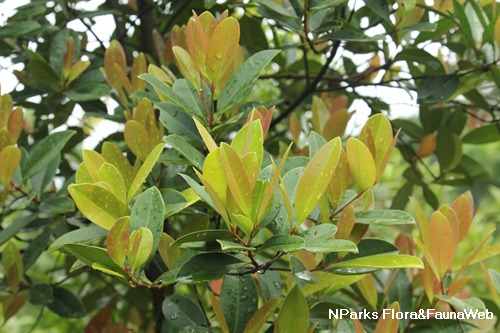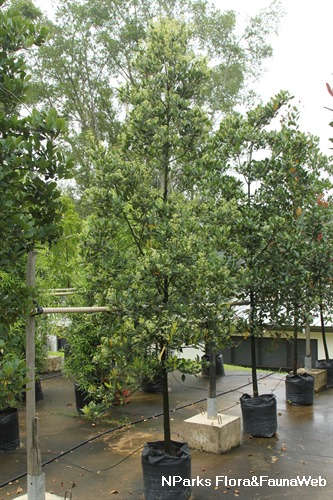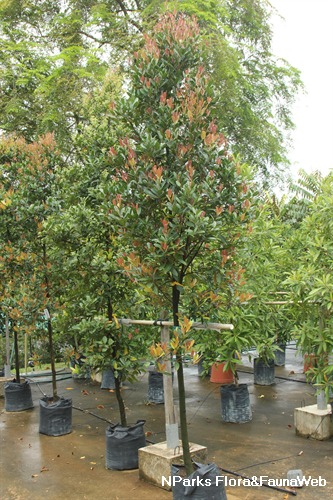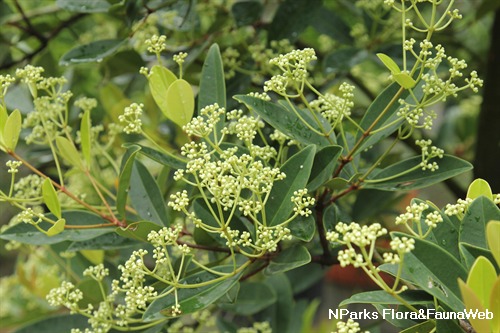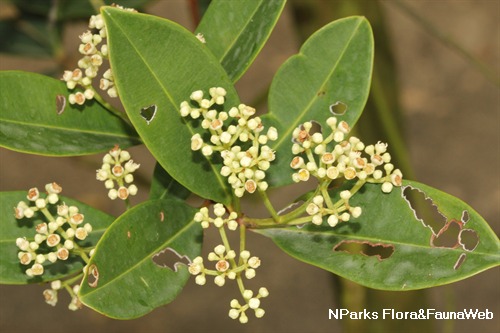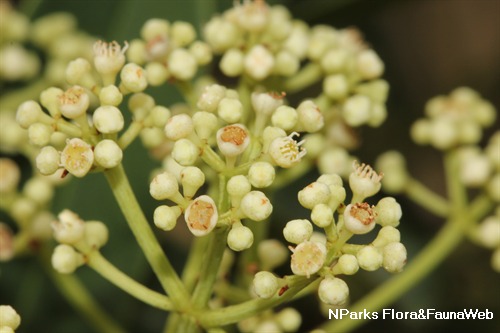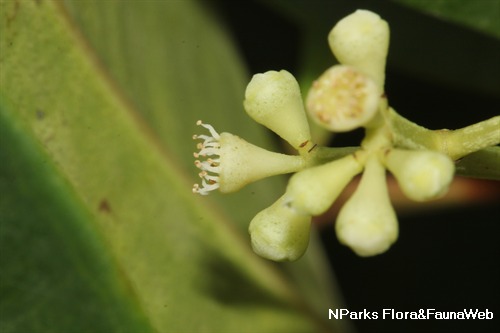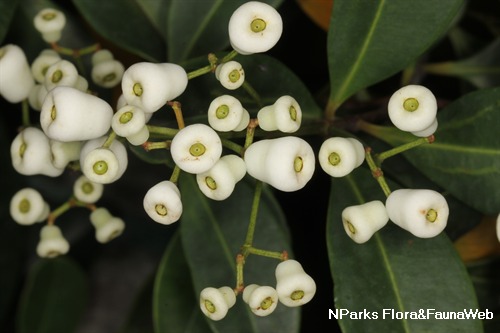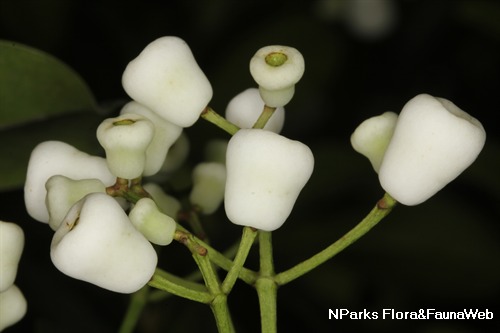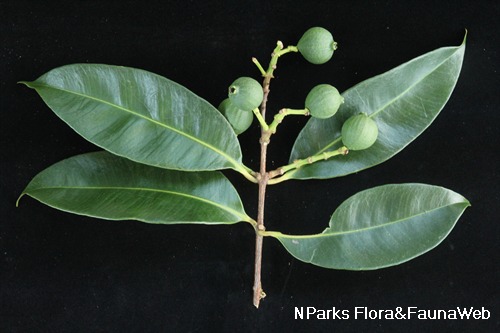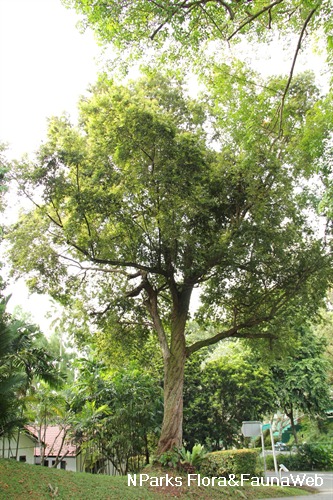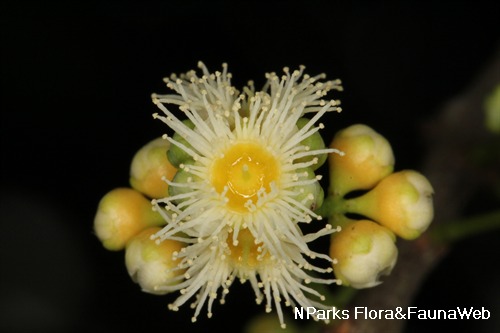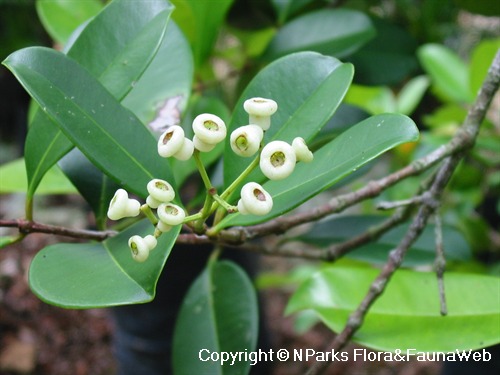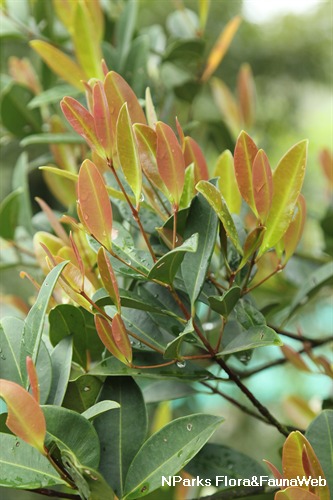
Back
Syzygium incarnatum (Elmer) Merr. & L.M.Perry
| Family Name: | Myrtaceae |
| Synonyms: | Syzygium cerinum (M.R.Hend.) I.M.Turner, Syzygium cerinum var. turbinatum (M.R.Hend.) I.M.Turner, Eugenia punctulata King, nom. illeg. hom., Eugenia cerina M.R.Hend., Eugenia cerina var. turbinata M.R.Hend.
|
| Common Name: | Kelat Samak, Kelat Gelam |
Name
Classifications and Characteristics
| Plant Division | Angiosperms (Flowering Seed Plants) (Dicotyledon) |
|---|---|
| Plant Growth Form | Tree (Medium (16m-30m)) |
| Lifespan (in Singapore) | Perennial |
| Mode of Nutrition | Autotrophic |
| Plant Shape | Oval, Irregular |
| Maximum Height | 27 m |
Biogeography
| Native Distribution | Malaysia, Singapore, Brunei, and Indonesia |
|---|---|
| Native Habitat | Terrestrial (Primary Rainforest, Secondary Rainforest, Freshwater Swamp Forest, Riverine) |
| Preferred Climate Zone | Tropical |
| Local Conservation Status | Native to Singapore (Endangered (EN)) |
Description and Ethnobotany
| Growth Form | It is a tree that can grow up to 27 m tall, and has a dense crown, and upward pointing leaves. |
|---|---|
| Trunk | Its trunk can attain 125 cm in girth size, and has papery flaky bark. |
| Foliage | Its opposite, stalked leaves have leaf blades that are leathery to thickly leathery, drop-shaped, narrowly drop-shaped or oblong, and 2.5–13 by 1.5–6.4 cm. Each leaf blade has a blade margin that is inrolled, has faint venation, 1 vein running parallel to the blade margin, and about 16 pairs of side veins. Young leaves are reddish to golden in colour. |
| Flowers | Its bisexual flowers are about 0.5 cm across and are found in 5–12 cm long flower clusters located at the ends of its twigs or axils of its leaves. |
| Fruit | Its fleshy fruits are greenish white, oblong to drop-shaped, and 1.2–1.4 by 0.7–0.8 cm. Its seeds are somewhat round and about 4 mm across. |
| Habitat | It grows in lowland, and often swamp forests, and by rivers. It occurs locally in Central Catchment Nature Reserve. |
| Associated Fauna | Its flowers are pollinated by insects, and its fruits are eaten by birds. |
| Cultivation | It can be propagated by seed. |
| Etymology | Greek syzygos, joined, referring to the paired leaves of this species; Latin incarnatum, flesh-coloured |
Landscaping Features
| Landscaping | It is suitable for planting in parks and streetscapes for its attractive new leaves, bushy crown, and fruits that attract birds. |
|---|---|
| Desirable Plant Features | Ornamental Foliage, Ornamental Form |
| Landscape Uses | Suitable for Roadsides, Parks & Gardens, Riverine |
Fauna, Pollination and Dispersal
| Fauna Pollination Dispersal Associated Fauna | Bird-Attracting (Fruits) |
|---|---|
| Pollination Method(s) | Biotic (Fauna) |
| Seed or Spore Dispersal | Biotic (Fauna) |
Plant Care and Propagation
| Light Preference | Full Sun, Semi-Shade |
|---|---|
| Water Preference | Lots of Water, Moderate Water |
| Plant Growth Rate | Moderate |
| Rootzone Tolerance | Moist Soils, Waterlogged Soils, Well-Drained Soils, Fertile Loamy Soils |
| Maintenance Requirements | Moderate |
| Propagation Method | Seed |
Foliar
| Foliage Retention | Evergreen |
|---|---|
| Mature Foliage Colour(s) | Green |
| Mature Foliage Texture(s) | Leathery |
| Prominent Young Flush Colour(s) | Red, Yellow / Golden |
| Foliar Type | Simple / Unifoliate |
| Foliar Arrangement Along Stem | Opposite |
| Foliar Attachment to Stem | Petiolate |
| Foliar Shape(s) | Non-Palm Foliage (Obovate, Lanceolate, Oblong) |
| Foliar Venation | Pinnate / Net |
| Foliar Margin | Entire |
Floral (Angiosperm)
| Flower & Plant Sexuality | Bisexual Flowers |
| Flower Colour(s) | Cream / Off-White, Green - Light Green |
|---|---|
| Flower Grouping | Cluster / Inflorescence |
| Flower Location | Axillary, Terminal |
| Flower Symmetry | Radial |
| Individual Flower Shape | Urceolate / Urn-shaped |
| Inflorescence Type | Panicle |
Fruit, Seed and Spore
| Mature Fruit Colour(s) | Green - Light Green, White |
|---|---|
| Fruit Classification | Simple Fruit |
| Fruit Type | Fleshy Fruit , Non-Accessory Fruit |
Image Repository
Others
| Master ID | 29724 |
|---|---|
| Species ID | 4033 |
| Flora Disclaimer | The information in this website has been compiled from reliable sources, such as reference works on medicinal plants. It is not a substitute for medical advice or treatment and NParks does not purport to provide any medical advice. Readers should always consult his/her physician before using or consuming a plant for medicinal purposes. |

